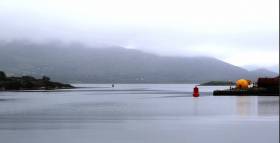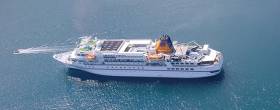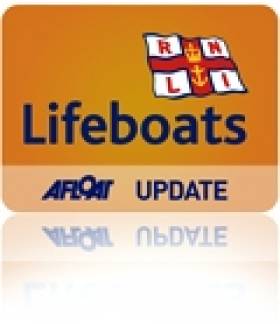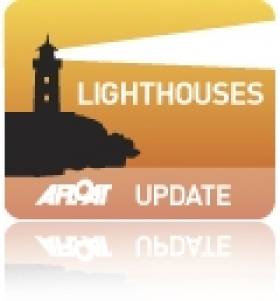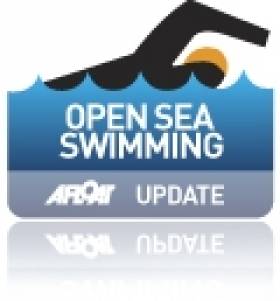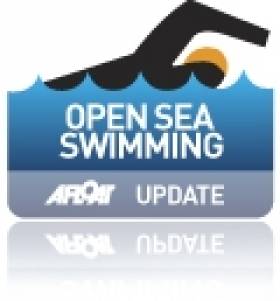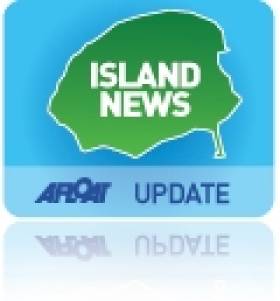Displaying items by tag: Bere Island
Appeal for Vigilance Over Submarine Cables After Last Week's Bere Island Power Outage
ESB Networks has appealed for vigilance at sea in relation to submarine cables after a fishing vessel cut power to West Cork’s Bere Island last week.
ESB Networks restored power to some 280 affected islanders at 11 pm on Friday last, January 5th, some 31 hours after supplies were cut suddenly on January 4th.
The operator confirmed that the outage occurred “ as a result of a fishing vessel accidentally coming into contact with a cable running from Castletownbere to Bere island”.
It said that “repair efforts started immediately, which included a diver safely locating the damaged cable so ESB Networks crews could carry out the required restoration work”.
Power was restored to all impacted customers by 11pm on Friday night,it said, and it apologised to all those affected by the disruption.
There was considerable upset at the incident at a particularly difficult time of year and with islanders dependent on freezers to store food supplies.
An ESB Networks spokesman declined to confirm the cost of the repairs, or whether the fishing vessel had offered to contribute.
The non-governmental organisation Coastwtch said the incident illustrated the “damage large powerful fishing vessels can have on the fragile nature” of the seafloor.
It called on the State to recover costs from “those who caused the damage”, and said that “our heart goes out to families left without power in winter cold”.
Coastwatch co-ordinator Karin Dubsky questioned why the island was dependent on one power cable and said a Heritage Council study 20 years ago had flagged concerns about this.
Given that submarine cables are set to increase during offshore wind development, she said it was essential that the cable “isn’t just fixed but that the cause is determined and published with planned action” to avoid a recurrence.
The ESB said that “damage to our network by third parties can occur from time to time – generally on overhead and underground cables on land - and we run extensive public campaigns on staying safe and staying clear of our network”.
“This incident serves as a timely reminder that similar vigilance should be applied by those at sea to submarine cables”,it said.
More information on its public campaigns is here.
Power Cut to West Cork's Bere Island After Damage to Undersea Cable
West Cork’s Bere island has been left without power for over 24 hours after an undersea electricity cable was damaged.
ESB Networks said a total of 281 customers remain affected by the power outage, which also affected the Castletownbere area of West Cork.
It said it was hoped to have all supplies restored late on Friday night as crews worked to identify the fault and make emergency repairs.
The power fault was reported at about 3.30pm on Thursday and affected some properties in Castletownbere and the entire island community on Bere.
While supplies were restored in Castletownbere, the ESB said it had to commission specialist divers to inspect the undersea cable.
It said it believed the damage was caused by a fishing vessel.
Bere Island in West Cork Sets August Date for Annual Regatta
Bere Island in West Cork has scheduled its annual regatta for August 8-13.
"Always popular and packed with fun, races, and games," say the organisers.
Bere Island has its own Watersports Club and sailing programme, which includes sail training weeks for adults and young sailors, which are ongoing at present and into early August.
Bere Island Water Sports Club supports its members to enjoy water-based activities around the shores.
New Navigation Buoy Installed at Lawrence Cove, Bantry
New navigation buoys have been installed at the entrance to Lawrence Cove, near the village of Rerrin on Bere Island, one of the most sheltered harbours in Bantry Bay on Ireland's South–West coast.
A marina at Lawrence Cove is located opposite the fishing port of Castletownberehaven at the North side of Bere Island. Lawrence Cove Marina is the only fully serviced marina between Kinsale and Cahirciveen making it an important stop–over location for cruising yachts.
Bere Island & Kinsale Welcome Cruise Ships
Spanish Armada, French Armada, English forces, Vikings, the Lusitania. West Cork towns have had their share of maritime history over the years but this coming week will see history in the making when new visitors, this time invited ones, will arrive by sea to experience some of County Cork’s gems.
This Thursday, June 9th, the German cruise ship, the Bremen, will anchor just off Bere Island and 100 German passengers plus crew will zip ashore on some of the ship’s 12 onboard Zodiacs. With Hungry Hill as its backdrop and the historical island its destination, passengers will land at Lawrence Cove Marina, where they will be whisked to the Heritage Centre to learn about the island, its history and culture. From there, they have the option of hiring bikes, joining a guided walking tour or participating in some unique experiences – pulling a pint in the village pub or footing turf, for example.
“The community of Bere Island has gone out of its way to customise experiences for these guests and we are confident that the welcome they have planned for them will result in exceptional feedback from the passengers and crew and future calls of even longer duration in coming years.
“We are excited by the opportunity we believe the West Cork Islands present for expedition operators such as Hapag Lloyd Cruises and are in no doubt about the economic benefit that direct calls such as these can deliver to the community. ” says Clodagh Henehan, Divisional Manager, West Cork for Cork County Council.
Later, on June 13th and again on the 20th. National Geographic Orion, with mainly American guests onboard, will call to Kinsale. Anchoring in sight of the spectacular, clifftop, Charles Fort, the Orion’s guests will enjoy historical walking tours of Kinsale Town and take in the Old Head of Kinsale on the Wild Atlantic Way.
This is the first season that the Orion has been deployed in Europe – it is more usually to be found in the Arctic and Antarctic regions. Combining adventure with luxury for its discerning and highly experienced travelers, this expedition ship also seeks out smaller harbours on its itineraries.
“Guests on these smaller cruise ships are seeking destinations where larger ships and mass tourism has not reached. It’s all about authentic experiences and West Cork, with all it offers, is ideal for them”, comments Clodagh Henehan. “Additionally, in recent research, 67% of cruise passengers said they returned to a destination after visiting it on a cruise. So, for us and for tourism development in the region, it’s a no-brainer.”
At the end of 2013, as part of its economic development remit for the region, Cork County Council identified the need to actively intervene to arrest the decline in cruise ship calls into Glengarriff, for which they were then responsible. They put in place a two-pronged promotional campaign that sought
to attract additional cruise ships into West Cork and to increase the shore excursions for cruise passengers in West Cork.
With decisions about deployment taking place some 3 years down the line, this is the first year that the efforts on the itinerary planning side are now paying off and the opportunity of attracting smaller ships into lesser known harbours has been realised. A further new cruise ship company is scheduled to call to Kinsale in 2017.
Additionally, Glengarriff which is serviced now by the Port of Cork, will have 7 ship calls in 2017, many of them new clients and all of them larger ships with an average of 600 passengers each. Significantly, one of these companies, Holland America Line, is one of the first American companies to call to Glengarriff which has traditionally appealed to a more European and UK market and it is hoped this will attract further US cruise operators to West Cork.
Castletownbere RNLI Lifeboat Help Injured Couple After Yacht Gets Into Difficulty Off Bere Island
#rnli – Lifeboat crew with Castletownbere RNLI launched yesterday (30 July 2014) to help a couple who had become injured when the 40 ft yacht they were sailing on, at Lawrence Cove, got into difficultly. On arriving at the scene, the lifeboat crew had to board the vessel and treat the injured woman before bringing the couple to safety at Castletownbere harbour in Cork.
The call for help was raised at 1.28pm, with the lifeboat arriving on scene fifteen minutes later. A local passenger vessel had been passing when the couple got into trouble and was able to offer assistance.
When the lifeboat came alongside the yacht, three of the volunteer lifeboat crew boarded the vessel and administered first aid to the couple. They did not wish to move the woman as she had received injuries to her back, so the lifeboat crew stayed onboard the yacht and returned with it to the shore. On arrival they were transferred to Cork University Hospital.
Commenting on the callout Castletownbere RNLI crewmember Paul Stevens said, 'Thankfully conditions were calm and we were able to reach the couple quickly. It was also fortunate to have the assistance of the local ferry when the lifeboat crew arrived and we are very grateful to them. The couple had sustained injuries when their yacht had got into difficulty and our priority was to get them back to shore as quickly and comfortably as possible. We wish them both a speedy recovery.'
#lighthouse – The Commissioners of Irish Lights (CIL) have unveiled a new light emitting diode (LED) light at Ardnakinna lighthouse on Bere Island, Co. Cork on Wednesday 18th June 2014. This sectored light marks the western entrance to Castletownbere. The white sector of the light indicates the safe approach to Bere Island Sound and the approach to Castletownbere Harbour which is the largest whitefish port in Ireland.
Ardnakinna Lighthouse is located in an area of outstanding natural beauty on the Beara Peninsula and a favourite among those who visit, is the Ardnakinna Lighthouse Loop Walk. This project, while upgrading Ardnakinna Lighthouse, will also provide reliable and low maintenance operational needs for the next 20 years, achieving an annual reduction in operation costs of approximately 24% for CIL.
Mr Eoghan Lehane, Operations & Property Manager of CIL commented "the exhibition of this new light marks another stage in the modernisation of many of our stations as part of a multi-year Capital programme. While providing improved reliability for mariners, the use of modern low powered LED lights offers cost effective solutions that allow the removal of diesel generation equipment with consequent environmental benefits and maintenance savings".
The exhibition of this new light marks a significant milestone within CIL's major Capital Refurbishment Project currently being carried out at the lighthouse. The project includes replacing the mains-powered 1500W lamp with a new low power flashing LED light source in the existing lens. The light range will be reduced from 17n miles White, 14n miles Red to 14n miles White, 9n miles Red and exhibited in the hours of darkness only but will keep the same flashing character.
The Mains-fail Standby Diesel Generator will be removed and standby power will be provided by duplicated 24V batteries and chargers which will reduce maintenance requirements at the station as well as the need for fuel delivery. The installation of the LED light-source removes the need to change lamps and reduces power requirements to the station resulting in lower electricity costs.
The upgrading of Ardnakinna lighthouse demonstrates CIL's commitment to the economic and sustainable delivery of aids to navigation services around the coast of Ireland while keeping our mariners safe.
Corkonian Is First Person To Swim Round Bere Island
#Swimming - Open-water swimmer Carol Cashell became the first person to swim around Bere Island when she completed her gruelling charity challenge on Saturday morning (31 August).
As previously reported on Afloat.ie, the Cork city resident had plenty of experience to fall back on when taking on the challenging 24km course around some seriously rocky and exposed coastline, setting out at 6.50am for an early start.
But she made short work of the feat, making it round the island in a blistering 7 hours 14 minutes.
Cashell was accompanied by RNLI crew members Marney T O’Donoghue, Sean Bawn O’Sullivan, Cian Murphy and Alan Cody and supported by her own team of Owen, Ray and Rob from Cork City.
The Castletownbere lifeboat Annette Hutton accompanied her for the final leg of the swim, and she was warmly welcome by her relatives, friends and RNLI supporters when she reached the finish line.
"This is a marvellous achievement and we are delighted that Carol completed the swim around Bere Island without a hitch," said local lifeboat fundraising secretary Sheila O’Driscoll.
"It is great for our local lifeboat that Carol is using her swim to raise funds for us and we are very grateful to her."
Lifeboat station mechanic Marney T O’Donoghue made a presentation to Cashell on behalf of the RNLI at a gathering in the lifeboat station.
Speaking afterwards, the swimmer thanked all who had supported her on the day and helped make her latest challenge a reality.
Cork Woman To Swim Round Bere Island
#Swimming - An open-water swimmer whose mother hails from the Beara Peninsula in West Cork is to complete a gruelling swim around Bere Island in aid of Castletownbere RNLI.
Carol Cashell, from Cork City, has set the challenge to raise funds and awareness of the RNLI, and the swim will take place this Saturday 31 August.
Having already completed the Cork-to-Cobh and Lake Zurich marathons, she has spent the winter months getting ready for the 28-mile swim around New York's Manhattan Island in June, closely followed by the 2-Way Channel Relay in July.
Cashell’s latest swim will be the 24km route around Bere Island, and this will be particularly challenging as some of the island’s coast is heavily exposed to the Atlantic ocean.
However, Cashell has plenty of relatives locally and they, along with the RNLI volunteers, will be supporting her on Saturday.
Local lifeboat fundraising secretary Sheila O’Driscoll, said: "It’s been a busy a summer for Castletownbere lifeboat and sadly there have been a number of tragedies around our coast in the last few months.
"We are delighted that Carol is doing this swim to help raise funds for our local lifeboat. Sponsorship cards are available in all the local businesses."
Speaking of the challenge, Carol Cashell commented: "I swam in Castletownbere last week. The jellyfish are much bigger than what we have in Cork Harbour at the moment - must be something in the West Cork water!"
The West Cork Islands of Bere, Dursey, Garnish, Heir, Long, Cape Clear, Sherkin and Whiddy are inviting visitors to 'explore the islands, experience island life' in a special island festival in June.
The idea behind the celebration from June 15 and 16 is to encourage visitors to see what life on an island is like. The island communities are saying 'be an islander for the weekend'. Enjoy reduced rates on ferries/cable car activities, services and accommodation. Jump on a ferry or the cable car at islander rates.
More details on the festival are here




























